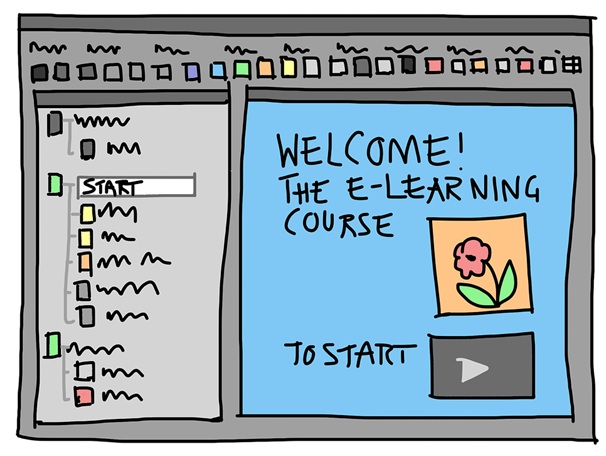E-Learning courses are an emerging trend in the online content distribution industry. As you could have guessed from the title, sharing your knowledge online could be rather profitable.
 In case you are skeptical about your abilities to build a demanded course from scratch and distribute it in a proper manner, we are here to help you believe in yourself.
In case you are skeptical about your abilities to build a demanded course from scratch and distribute it in a proper manner, we are here to help you believe in yourself.
Turns out, E-Learning course creation isn’t something very time- and effort-consuming. With the help of the right approach and following these steps, you will be able to…
Well, once again, “Develop an online course, make piles of money, bring the knowledge to the world and live happily ever after.”
Fairytale endings aside, if you feel like you have enough knowledge in certain aspects and want to share it in the form of an E-Learning course, our friends at Belitsoft (a company specializing in building LMS’ and other eLearning software) have prepared a set of steps to help you turn your dream into reality.
Step #1. Choose and Research Your Target Audience
When you more or less know what kind of knowledge you are ready to bring to the world, you should figure out which audience will be interested in getting this knowledge.
It is important to know every segment of your potential audience before starting to develop the course. If possible, try to gather feedback via survey or by interviewing the audience you are about to deliver the course to.
You need to understand the needs and motivations of the target audience. In-depth understanding of what the potential client tries to achieve by utilizing your production.
Also, to choose the tone for your online course, research is an absolute must. As Christiana Allen, Resumention E-Learning consultant stated for JoomlaLMS, “Researching your audience is vital since it will affect every single aspect of your E-Learning course, including tone of voice, style, accessibility and more”.
In short, don’t act blindly, maybe you would figure out there is no target audience for your course and you’ll save yourself some effort and money. Hopefully, after making this research you’ll still be able to create the course.
Step #2. Choose the Tools to Create the Course
You’ll need authoring tools for course creation. You have to assess the skills and abilities of the team that will be working on course creation to choose the best options. Ideally, the course engineer will use the most technically advanced authoring tool that wouldn’t take too much of their time.
If you and the members of your team don’t possess a strong knowledge of programming and graphic design (as is often the case), there are two useful options.
- Hire an eLearning development company. Thankfully, the industry is developed enough to give you a lot of contractors to choose from.
- Use some of the popular authoring tools. They often have premade course templates to make it easier on the people new to the job.
If you have an advanced designer in your team, you can go beyond basic features and functions. For the first online course, a generic set of functions will be fine. Later you will be able to dive in deeper for a better course map or other advanced features.
At the moment, Lectora and Captivate are among the leaders in courseware development tools. You can also explore your options on the market.
Courseware development websites like E-Learning Brothers help with that. You might need stock photos for illustrating the point on the learning map – sign up to several photo stocks.
Also, if you are new to developing, Lynda.com might be useful as you could take a lesson or too on using the development tools.
Step #3. Plan the Educational Journey and Add Multimedia to the Course (But Not Too Much)
This is the most important part here. After researching the target audience and choosing the tools to develop the course, you start to develop it.
It all begins with educational path planning. You have to get the learners from zero points to knowing the topic as well as you do (or to the level you’d like to teach them).
Creating this route is tough, and filling it with the actual content is even more challenging. This part is called storyboarding. You use text, images, videos to get the info into learners’ brains.
Writing Populist is a very helpful writing guide that can help you shape your storyboarding.
Integrating multimedia into the course might be tempting as these fancy instructional videos make the engaging effect.
“For effective learning, whether it is instructor lead, video, self-guided, or E-Learning, you must: make it engaging; use the right methodology, and connect the dots for the learner.”
Michael Milroy, E-Learning expert from Dancor Solutions says.
If it is your very first E-Learning course, keep video and graphic elements to a minimum. That way you will lower your stress level and time of the development.
Completely omitting these elements would also be a mistake though.
Step #4. Choose the Platform You Will Use for Distribution
If the course creation is in the books, you can choose the best way to provide the course to the users. You can wrap up the content in the downloadable package, or host it on an online E-Learning platform (Such as Udemy, or Coursera).
The most up-to-date option is choosing a cloud-based learning management system (LMS). The market used to be estimated at $5.05 billion in 2016 and grows exponentially.
Cloud-based LMSs are the most popular ones. They give the ability to integrate quizzes, create educational calendars, assign deadlines to the learners.
Among the leaders in the industry are TalentLMS and Docebo. There are free options on the market as well. If you choose the LMS that charges a monthly (or yearly) fee, make sure you can afford this amount allocation from your budget. If your budget is slim, have a look at free software.
Step #5. Publish and Promote the Course
When all the preparations are behind you and the course looks complete, it is time to upload it online.
As you have already gone through the procedure of choosing tools to create the course and selecting a learning management system to distribute it, putting it online won’t be a very difficult task.
That is assuming all the content is perfectly wrapped up in the form of the course.
As for promotion, this is where the first step plays the part. As you were researching for the target audience, you should have thought about the channels that course’s potential buyers will use to find it.
If you have a well-established channel to distribute the course, you’ll be alright in terms of financial stability. Distributing and advertising the course on your SEO-friendly website, via social accounts or using some world famous platform.
Content marketing could also be helpful. One main thing, you ought to have these channels.
Summary
This article is not a detailed guide to creating an online E-Learning course. However, it is a perfect fit for someone who is thinking about sharing some knowledge they possess in that format.
Always start with the research of your target audience. That is the key to beginning to construct a successful course. The other steps are also important, and if you manage to do the things in a proper manner in the right order – maybe we’ll soon hear about your success in the digital space.



